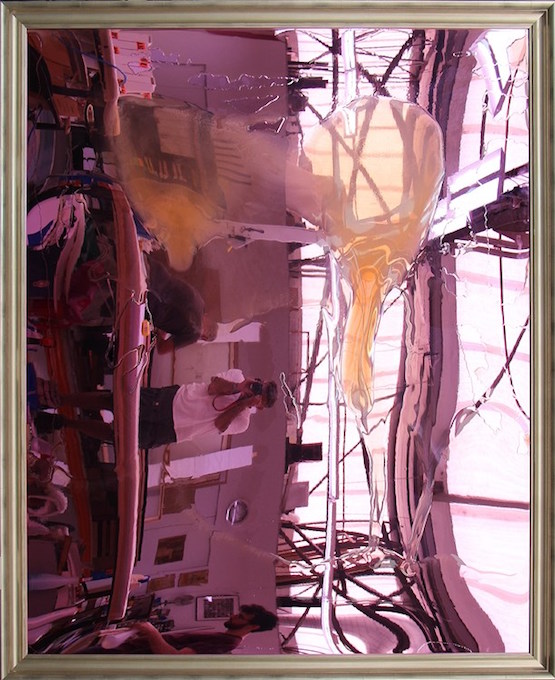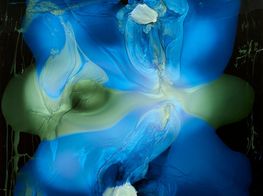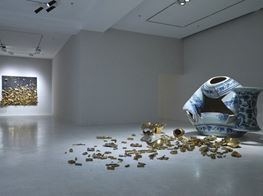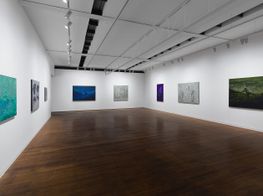Dale Frank at Art Los Angeles Contemporary
Dale Frank is one of Australia's most celebrated and critically acclaimed artists with a career spanning more than 30 years. He has been the subject of numerous solo exhibitions including a retrospective at the MCA in Sydney in 2000. His work is held in the collections of every major public collection in Australia as well as numerous private and corporate collections in Australia, Europe and the US.
Ocula talked to Dale Frank following his recent exhibition at Neon Parc in Melbourne, and as Neon Parc presents a solo show of his work at Art Los Angeles Contemporary.
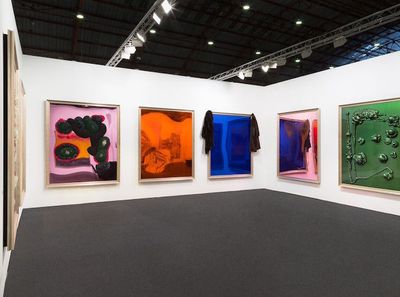
Many of your works challenge the notion of artist as creator and audience as passive observer; from your performance works during the late 1970s to your more recent varnish paintings where the reflection of the viewer is just as much a part of the work. How do you think your latest works with perspex shown recently at Neon Parc further complicates these customary roles of artist and audience?
The recent works I’ve made, or the shift that has occurred, say from working on canvas to perspex and other materials, has allowed a new dimension in the works, both spatially and conceptually. I feel as though the new paintings are much more intimate as opposed to purely reflecting what the viewer sees or projects. Of course the artist is complicit in the work, the audience does not merely create the work, nor activate it but in a sense the work is completed when it is being experienced - the paintings are extremely difficult to document, so, like performative works, they must be experienced in person.Image: Dale Frank, His B's made funny honey, 2015. Polyurethane on anodised perspex. 210 x 170 x 8 cm. Image courtesy of Neon Parc
Much like the varnish paintings, your latest works on perspex are viewer-activated via reflection, but with an added dimension of distortion. Could you tell us a bit about your experimentations with perspex as a medium?
I’ve worked with perspex and acrylic sheets since the early 1980s—by melting, adding pigments, painting directly on the surface and using various chemicals to manipulate the materials. The paintings have developed the sense of the viewer in the work, to the point where they are a crucial element to each work. These works don’t exist unless someone’s looking at them. All you have to do is try and take a photograph of one without trying to appear in it and it’s impossible. What the viewer sees on first glance is not a flat image, but a surface first manipulated by time and space (intentional distortion) prior to concentrated chemical conceptual manipulation that then traps , if you like, the viewer not only in the gaze, but in the work itself ... If my work is a kind of “mindscape”, or Hubble image, it is not because they are depictions, that is, because they are paintings of an image of ideas, the places we live, or deep space, but because they harness the same entropy—the same chemical reactions—across the surfaces that play out across the universes.There is an element of luxury in the works exhibiting at ALAC—draped fur in A clear conscience, as well as the opulent hues of amber, gold and cherry-red in the works. Was this something you were trying to intentionally convey?
To convey a element of luxury at an art fair could be seen as theatre! Another earlier work from the Neon Parc exhibition also used furs. Some paintings have employed shattered glass sprayed or in piles across the paintings surface instilling in the viewer a sense of diamonds or stars glistening in a void. But luxury itself, as an aim or concept is not anything I have intentionally worked to achieve. It is only of interest to me in the sense of perhaps the view from the painting ... laying in the gutter looking up at the stars …
 Image: Dale Frank, Adding insult to injury with a hot potato, 2015. Polyurethane on anodised perspex, 210 x 170 x 8 cm. Image courtesy of Neon Parc
Image: Dale Frank, Adding insult to injury with a hot potato, 2015. Polyurethane on anodised perspex, 210 x 170 x 8 cm. Image courtesy of Neon Parc
The title of these works seem randomly generated, Adding insult to injury with a hot potato, His B's made funny honey, Anchovies on heat, etc. yet they are effective in grabbing your attention. Do you have a process when it comes to titling your works?
Titles are the time in which I am doing the work. Everything: when I’m in the studio, and thinking about the work, everything around me is very much an input into that. Whether or not it’s something trashy or something profound, it’s an input. The same for any writer: it’s what goes on around them, their life. And the titles are very much from that same period (as each painting is made): they’re based in reality. The titles remind us of the creative intercession in these ‘chemical’, material and conceptual exchanges taking place within the painting: snippets from life conversations, things read, heard, influences at large, big and little ideas that might suggest a subject, but perhaps better reflect the life of the artist in parallel—forming a montage whose doubtful logic might still truly reflect the chaotic complexity of influence. Indeed, of all the things running through our minds everyday, only some cross the liminal threshold into speech or writing, or, in this case, the title of a painting. And these concatenations, these synapses, which are then set in language compare to the reactions fixed upon and within the paintings, chemical reactions within a continuation of matter. Image: Dale Frank, Anchovies on heat, 2015. Shattered glass, polyurethane on perspex. 210 x 170 x 8 cm. Image courtesy of Neon Parc
Image: Dale Frank, Anchovies on heat, 2015. Shattered glass, polyurethane on perspex. 210 x 170 x 8 cm. Image courtesy of Neon Parc



